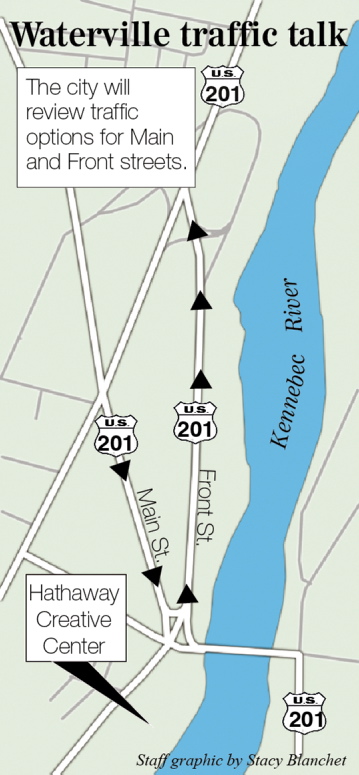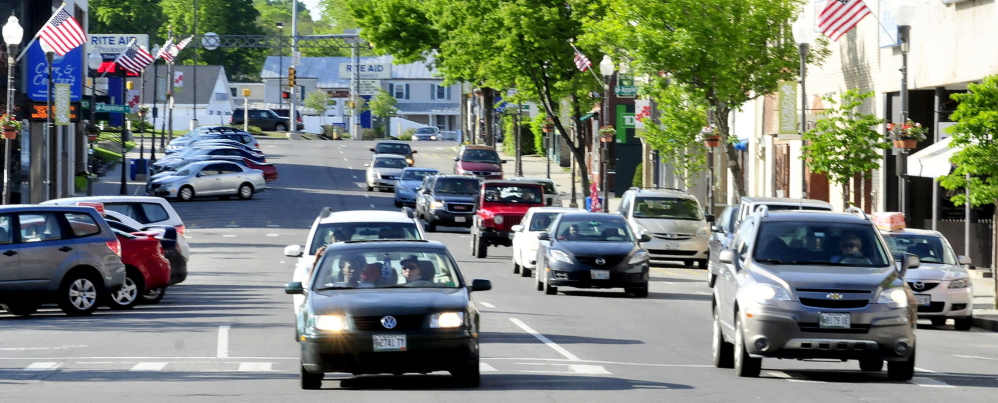WATERVILLE — Should two-way traffic return to Main and Front streets downtown? Would it make downtown safer for both pedestrians and motorists, draw more people downtown and enhance the overall ambiance of the area?
Those are some of the questions city officials are discussing as they re-examine traffic patterns on both Main and Front streets downtown.
City councilors voted May 20 to apply for a state grant to study pedestrian crossing improvements at the intersection of Water, Main, Front and Spring streets, just south of downtown.
The $25,000 state Department of Transportation Planning Partner Initiative Grant requires a local match of $25,000, and city officials propose to use Hathaway Creative Center tax increment financing funds for that match.
Council Chairman Fred Stubbert, D-Ward 1, asked that the traffic pattern downtown be studied in conjunction with the intersection improvement study. Stubbert said any changes made to the intersection will impact downtown.
City Manager Michael Roy said when the intersection improvement study goes out to bid, firms also could be asked to estimate the cost for doing a downtown traffic study.
Stubbert is adamant that two-way traffic on Main and Front streets downtown is necessary to make the area safe and more attractive to shoppers, diners and others.
“You can see that every day,” Stubbert said. “It’s like a racetrack down there.”
Years ago, the downtown had a two-way traffic system, but it was reconfigured to become one-way as part of an urban renewal project in the late 1960s, according to Stubbert.
While city officials do not know what it would cost to convert to two-way traffic, a study could include an estimate for that work, he said.
“It’s still in the planning stages as to what the study is going to do, but we’re planning on getting it done this year so we can apply for a federal grant in fiscal year 2015,” he said.
Jennifer Olsen, executive director of the Waterville Main Street Program, says it is important for pedestrians to have a pleasant experience when they are downtown.
“I think that the current configuration of traffic is a problem for Waterville,” she said. “I do see that as a challenge.”
But, she said, any decision about making traffic two-way downtown should include community input.
“It’s really the community of Waterville that gets to decide — this has got to be a public process,” she said.
HATHAWAY CONNECTION
When the Hathaway Creative Center was developed in the former C.F. Hathaway Co. shirt factory on Water Street, just south of downtown, owner Paul Boghossian said it was important that improvements be made to the busy intersection of Main, Water, Spring and Front streets to make it more pedestrian-friendly for people going to and from downtown. The city promised to make improvements there.
Like Olsen, Boghossian believes that in order for a downtown to be vibrant, people must live there, and pedestrian access is critical to a downtown’s success. Boghossian said Thursday that he agrees with Stubbert that two-way traffic would benefit downtown.
“He’s absolutely right,” Boghossian said. “I’m no urban expert, but I am an amateur urban guy. There are very few downtowns where one-way traffic works on Main Street. The only one I can think of where it works OK is Rockland.”
Boghossian owns three former mill buildings, including the former Hathaway shirt building, on Water Street. The Hathaway building has 68 apartments on upper floors and offices and retail businesses on lower floors. More than 500 people live and work in the building, and he plans to develop the two other mill buildings in the future, he said.
“I will say that it is critical that we make downtown more pedestrian friendly, as it is not, and that we need to do more on the aesthetics of downtown,” Boghossian said. “It doesn’t look as good as it could, and there are people working on it, so I’m encouraged.”
Boghossian said he does not have a personal stake in changing Main Street to two-way traffic.
“But I do really want to see downtown prosper,” he said. “Personally, as far as Hathaway is concerned, it doesn’t make a difference to me, but I do think it makes a big difference to Waterville. It would make a big, big difference in terms of how downtown feels.”
A study done in 2009 on the intersection south of downtown listed options for improvements that included digging a tunnel, building a bridge and making street-level changes, according to Stubbert and Olsen. At the time, the city deemed the options too costly, and improvements were never made.
But councilors last week decided to apply for the $25,000 state grant that, with a local match, would fund the study.
The state Department of Transportation would have a role in determining what improvements would be made at the intersection, since Main Street is a state road — U.S. Route 201.
While the City Council would initiate work to move to two-way traffic downtown, DOT would make the final decision, according to Stubbert.
Meanwhile, Mayor Karen Heck, whose opinions on city issues are often at odds with Stubbert’s, said she concurs with him on the need for exploring two-way traffic downtown.
“I think that any time Councilor Stubbert and I agree on an issue, it’s worth exploring,” she quipped. “I think that there are a lot of reasons to explore that.”
While there are challenges associated with changing to two-way traffic, the issue should be studied, according to Heck. She said that if a two-way traffic system is determined not to be feasible, then there should be only one, one-way traffic lane downtown instead of the current two, because the downtown is very difficult to navigate the way it is configured now.
“I would love to see two-way traffic,” she said. “Two-way traffic, I think, would be good for business. Slowing down traffic on Main Street would be great. It would bring more visibility to the stores who don’t get as much visibility right now because traffic is speeding.”
Making traffic two-way downtown has been talked about for a long time, Heck noted.
“While change is difficult for many people, it doesn’t mean it’s not worth exploring and looking at,” she said.
Police Chief Joseph Massey said he would reserve judgment on whether two-way traffic should be instituted until he sees a plan for such a change and knows what it would mean from a public safety standpoint.
“I’d like to see whatever is best for the downtown, and I’m not willing at this point to say, âAbsolutely, I recommend it,'” he said.
Stubbert recalled that when Gov. Paul LePage was Waterville mayor, he went to MIT for a conference where six communities in the country that had undergone urban renewal were analyzed. Stubbert said one of the things the conference report said about Waterville is that people are reluctant to park downtown with the current traffic configuration.
“The analysis showed that we’d made a big mistake by going one-way,” Stubbert said.
Amy Calder — 861-9247acalder@centralmaine.comTwitter: @AmyCalder17
Send questions/comments to the editors.





Success. Please wait for the page to reload. If the page does not reload within 5 seconds, please refresh the page.
Enter your email and password to access comments.
Hi, to comment on stories you must . This profile is in addition to your subscription and website login.
Already have a commenting profile? .
Invalid username/password.
Please check your email to confirm and complete your registration.
Only subscribers are eligible to post comments. Please subscribe or login first for digital access. Here’s why.
Use the form below to reset your password. When you've submitted your account email, we will send an email with a reset code.